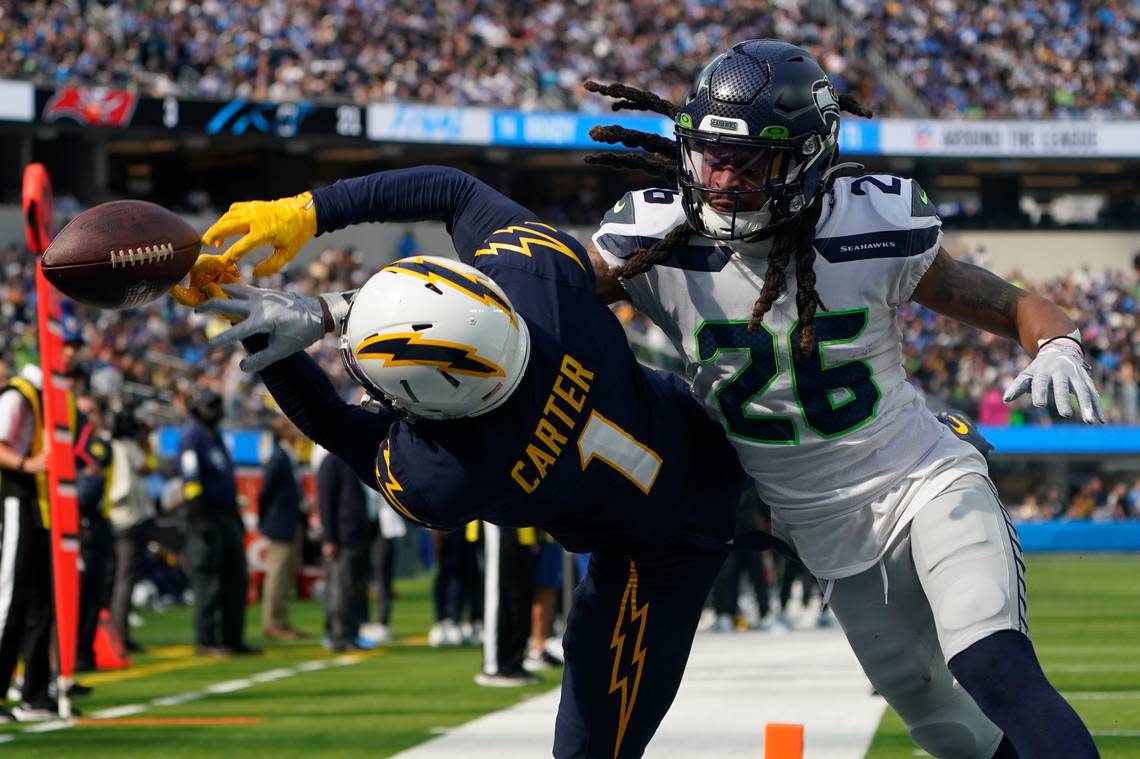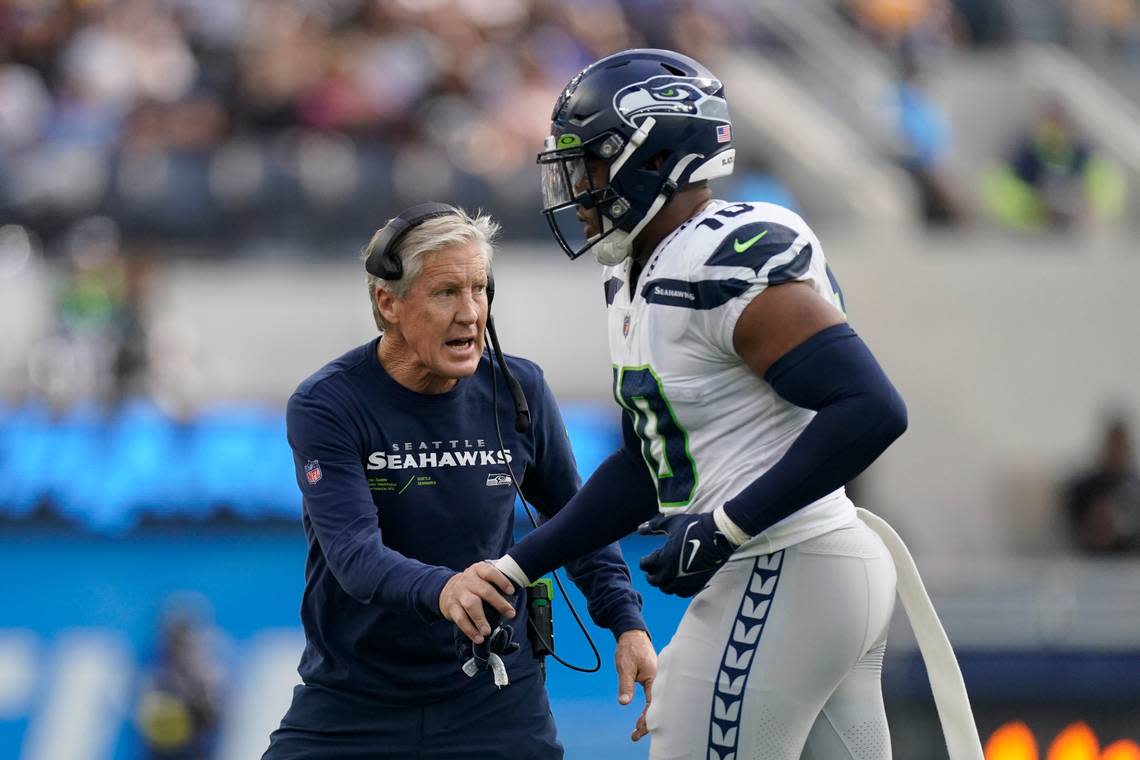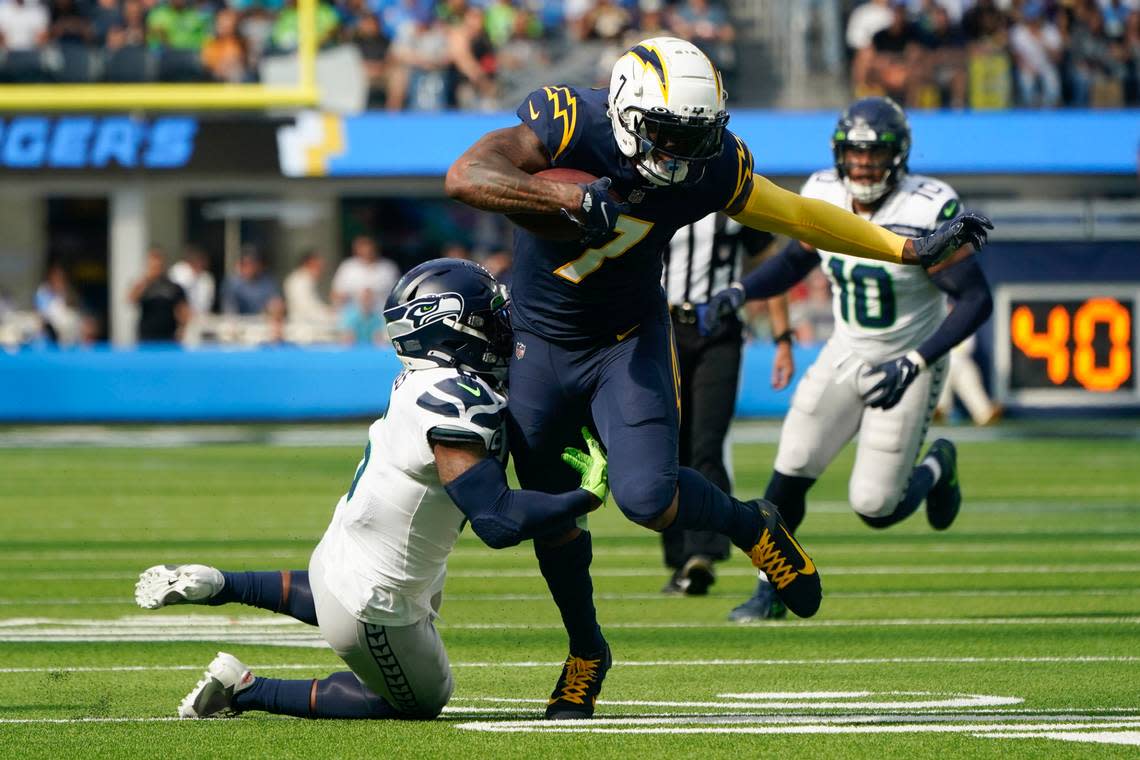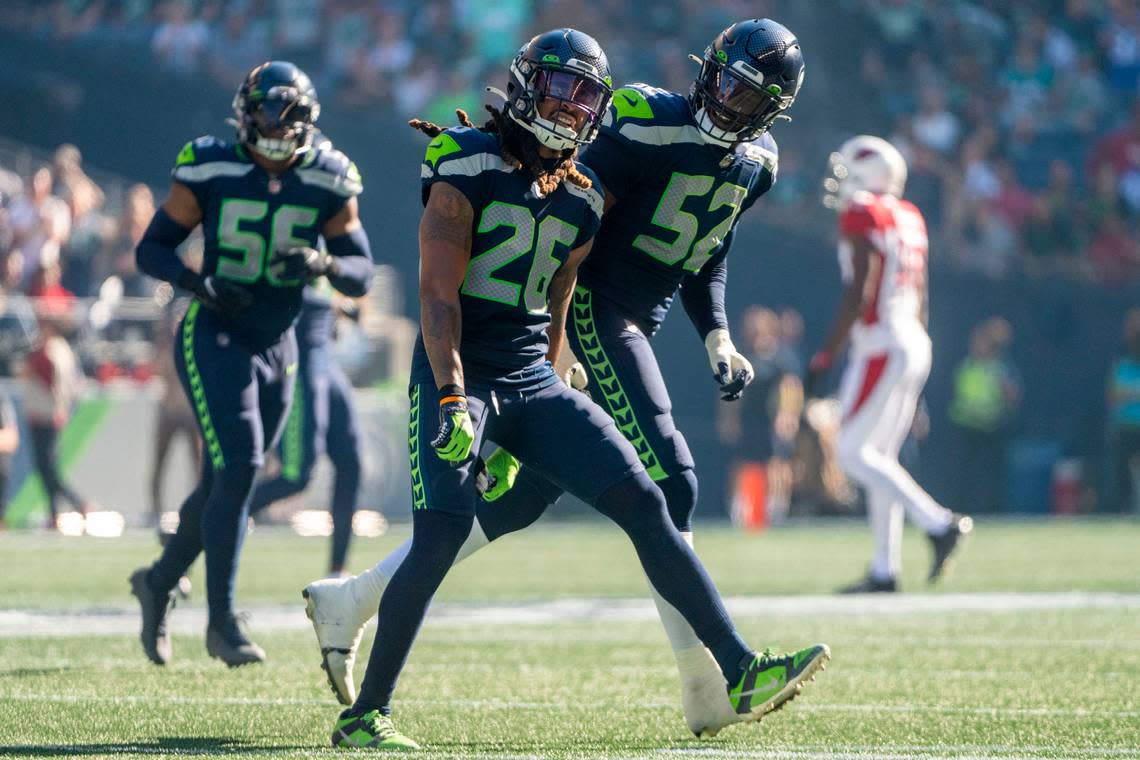How players-only meetings have U-turned Seahawks’ defense and season, who’s leading them
Quandre Diggs and Al Woods, Jordyn Brooks and Ryan Neal, they’d had enough.
They were what much of the Pacific Northwest was: Fed up.
The Seahawks were last in the NFL in yards allowed and rushing defense. They had given up 84 points and 946 yards in consecutive games, at Detroit and New Orleans.
Seattle was 2-3 instead of 0-5 despite, not because of, its defense.
Two weeks ago Taysom Hill, Alvin Kamara and the Saints steamrolled the Seahawks with 235 yards and three rushing touchdowns in a 39-32 Seahawks loss. After that, Diggs, Woods, Brooks and Neal led a return to what the defense used to do with Bobby Wagner, K.J. Wright and its Legion of Boom secondary.
They revived players-only meetings before each game. No coaches. Straight talk.
“We took some steps in having extra meetings outside what we do normally, with just players only,” Neal said. “Just seeing how we see stuff.
“It always works better that way when you do that, because then you get to hear each other speak on plays and on concepts.
“It’s finally coming together. We are just growing. We are taking steps. We are making strides. Only thing I keep thinking about is: I can’t wait to get back and do it again. Just keep going. Keep attacking.”
Since the players-only meetings began, the Seahawks have held the Cardinals’ offense to three points and the Chargers’ to 14 before a garbage-time touchdown late. That was Sunday in the defense’s, and team’s, most complete performance yet.
The Seahawks (4-3) are have gone from last to first in the NFC West since the players restarted their meetings and accelerated their togetherness.

What the players meet about
These gatherings going over details from a players-only perspective became extra important after coach Pete Carroll and coordinator Clint Hurtt changed Seattle’s base defensive system. They installed a new 3-4 scheme with varied coverages and blitzes for 2022, after 12 years running Carroll’s 4-3 with Cover-3 zone as the Seahawks’ base scheme.
For five games, players often were not getting what the coaches had installed. They were not at all executing it as designed.
“When I first got to Seattle and the team, we used to do it all the time,” said Neal, who joined the Seahawks as a free agent in September 2019 from Atlanta and Philadelphia. “I think maybe it was on Fridays, or something like that, where Bobby and K.J. and ‘B-Mac’ (safety Bradley McDougald) would call a couple plays and just talk. Talk things out, how we see it and stuff like that, so we could be better on game day.
“We just started doing stuff like that again, just meeting with each other and just getting an understand so we know how stuff works and building that chemistry.
“Guys like me just wanted to get the stuff right.”
Carroll, Hurtt and new defensive secondary coaches Sean Desai and Karl Scott changed to the 3-4 defense to maximize Seattle’s youth and speed. That was particularly for Darrell Taylor, newly signed Uchenna Nwosu and rookie second-round draft choice Boye Mafe off the edges as outside linebackers and Brooks at inside linebacker.
Carroll sought to fix the lack of consistent pass rush and the fewest turnovers over a season in team history in 2021, when the Seahawks sunk to 7-10 and out of the playoffs for just the second time in 10 years.

Stopping the run first
The prerequisite for all the blitzing, edge rushing with Taylor, Nwosu and Mafe plus the new mix of man-to-man and zone coverages to confuse quarterbacks: stopping the run first.
The first five games of this season, Seattle stopped no one’s run. The players talked of not being in the right run gaps, missing assigned lanes, having poor run “fits” and awful tackling.
Since their debacle in New Orleans, Woods, Bryan Mone, Poona Ford, Shelby Harris and the Seahawks’ defensive linemen have been attacking more, scanning and reading less. Carroll and Hurtt have freed them to be more aggressive, less reactive. They aren’t preoccupied with fulfilling assignments with proper run fits. They are attacking the guys across from them and mashing ball carriers.
Since then, the Seahawks limited Arizona’s depleted running backs to 44 yards on 18 rushes in a 19-9 win. They blockaded Austin Eckler and the far more potent Chargers to 31 yards on 12 carries Sunday in Inglewood.
Because of no production with the run on early downs and so many third and longs, offenses are a combined 9 for 31 converting on third downs against Seattle the last two weeks. That 29% rate is 10% below the league-wide average for third-down conversions from 2002-21. It’s a conversion rate 15% lower than what Seattle was allowing on third downs before the Arizona game.
Voila! Defense — and season — changed.
“We are getting stops when we need them,” Diggs said over the boomin’ bass of the visiting locker room at SoFi Stadium following the win over the Chargers. “Any time you can hold a team to — they were 5 for 15 on third down — that definitely helps.
“Our big guys up front are eating,” Diggs said. “If you can make a team one-dimensional, that damn sure helps.
“We’ve understood that if we stop the run, then those guys get to rush the passer. That’s what’s been cool, seeing the big guys eat.
“It’s definitely been dope.”

Why Darrell Taylor has resurfaced
The Seahawks have defended 92 drop backs to pass the last two games. While that sounds cool to fans of video game-like football, it’s sweet music to the ears of Seattle’s veteran defensive captains. And their pass rushers.
“I mean, once you can stop the run, you take half a team’s game plan out. You make a team one-dimensional,” Diggs said. “We get to switch our coverages up in the back end, make them really work. That’s really what it’s been.”
It’s also helped Seattle that the Cardinals and Chargers have nowhere near the run mentality and personnel the 49ers and Saints do.
But the 6-1 New York Giants come to Lumen Field on Sunday with the NFL’s second-ranked rush offense, 173.4 yards per game.
Seattle’s defense stopping the run has made Taylor the player he was supposed to be in this new 3-4. Carroll and Hurtt benched their 2020 second-round pick last month. He was not setting and holding his outside run lanes. The sturdier, sounder Mafe replaced him as the starting left outside linebacker. Taylor was reduced to situational edge rusher on obvious passing downs.
Those passing downs are more frequent and more obvious the last two games. Freed from having to read and take on run blockers coming at him, Taylor is now on a single, fast track zooming past offensive tackles and into quarterbacks.
“We didn’t stop the run the first few weeks,” Taylor said. “And now we’re doing it.”
On another third and 10 for Seattle’s defense, Taylor slammed into Los Angeles’ Justin Hebert on Sunday for a sack and strip of the ball. Taylor returned the fumble inside the Chargers’ 20-yard line. That set up Jason Myers’ field goal for 17-0 Seahawks lead in the first quarter.
“I’ve been rushin’ my butt off,” Taylor said.
It was the defense’s third big play of the opening period in L.A. Mafe pushed the Chargers’ right guard into Eckler to stop a fourth-and-inches play for no gain in Seattle territory on Los Angeles’ first possession of Sunday’s game.
Seattle’s defense has stopped its opponent on six of seven fourth downs since its turning point from New Orleans.
“The only thing that’s changed is our defense has taken a different approach,” Taylor said.
“We felt like we owed our offense.”

Neal, starting the last two games at strong safety over Josh Jones, intercepted Herbert over the middle at midfield on another third and long in the first quarter Sunday.
Geno Smith and the Seahawks’ offense converted those three defensive plays into 17 points. Seattle never trailed and never was tied against the Chargers.
“There were these few weeks from the first game to the last two weeks that we just weren’t hitting it right,” Carroll said. “We made some adjustments. Clint did a great job with the staff and they reached the players. The players are on board in a way that is giving us a chance to really move forward and continue to get better.
“We have a long ways to go, and we have a lot of improvement we can still make. That’s an exciting thing for a coach.”
